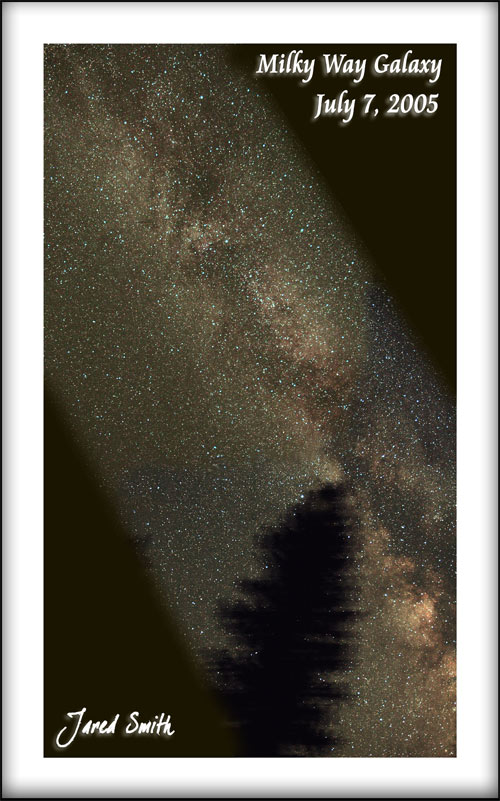
This section is dedicated to wide-field views of the Milky Way galaxy and for images of objects inside our galaxy that don't fit anywhere else. The Milky Way galaxy is the galaxy we live in. It is a platter shaped group of around around 400 billion stars - our sun being one of them. Nearly everything you can view in the sky is part of our own galaxy, though we estimate that there are over 100 billion galaxies in the universe. Because the Milky Way is relatively flat shaped, the majority of the stars within the galaxy can be viewed in a band that goes across the sky. You may have seen this cloud looking, slightly immuminated, 'milky' band on a clear night.
Mouse over the image to view labels
For my first real astrophotography session of the summer (yes, I know it's already August) I decided to
capture a wide field image of the Milky Way. While I'm
happy with this image, I think it could have been much better. The framing was a bit difficult due to a
very limiting camera mount to my telescope (I just ripped the head off a mini-tripod) so I wasn't able to frame
each shot very well. The result is much more narrow than I wanted and it was a major pain to get the mosaic
stitched together.
Mosaic of 4 images, each one a combination of 4 exposures of 3 minutes each (full-size image is 1240X5144 pixels)
Piggyback on my Celestron C8NGT
Processed with IRIS and Photoshop CS
Nikon D70 w/ 18-70mm lens
F/4
ISO 800
Focal Length of 18mm

Taken from a VERY dark site while spending a night helping out at girl's camp, this picture shows much nebulosity and structure of the Milky Way galaxy. The LARGE dark area is a pine tree. The dark bands in the Milky Way are dark nebula - areas of dust and debris that block the glow of the stars behind.
This image is a composite of two images. Each one is 3X3 minutes registered and stacked in Iris and processed in Photoshop. Taken with an unmodified Nikon D70 on an AS-GT mount. Nikkor AS-S DX 18-70mm lens at 18mm. ISO 800 and f/4. The framing was kinda bad and after stitching the two images together, I decided on the somewhat awkward angle so as to not lose the bright nebulous M20 region at the bottom right.
Mouse over image to see labels
A view of the Cygnus and Cephus region of the Milky Way. You can begin to see nebulocity (glowing colors) in the images. Nebulas are huge clouds of gaseous (mostly Hydrogen Alpha and Beta) materials mixed in with interstellar dust. Nebulas are classified as planetary nebulas, supernova remnants, and diffuse nebulas, including reflecting, emission, and dark nebulas. Also in the photo are several star clusters, groups of stars held together by mutual gravitational forces. Star clusters can be comprised of anywhere from 2 to several million stars.
6X30 seconds
5 dark frames averaged and subtracted in Photoshop
18mm focal length,
F/3.5
ISO 800
Tracked with home made barn door mount
Images stacked in MaximDL
Final processing in Photoshop CS